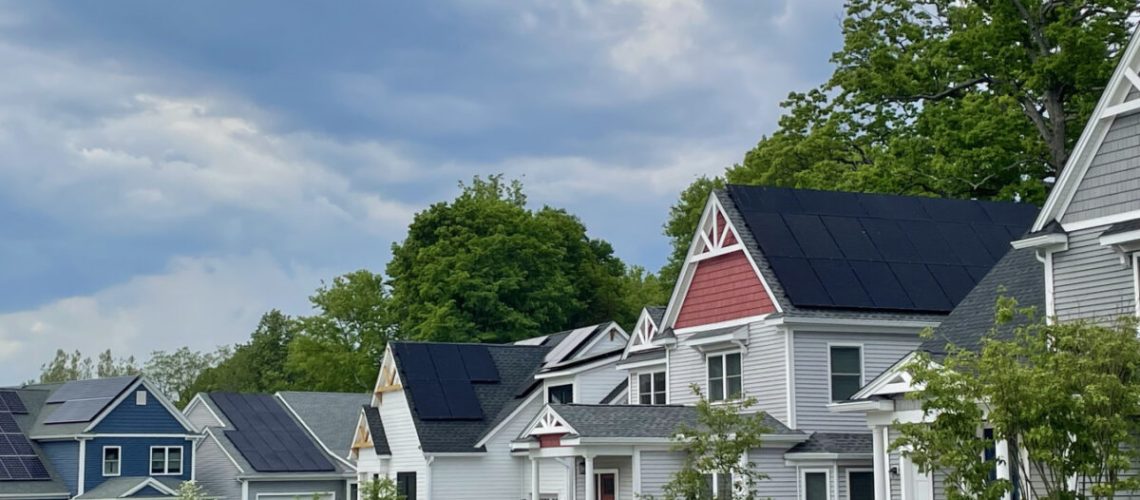California solar homeowner believes the main importance of rooftop solar is that electricity is produced where it is consumed, but it offers several additional advantages.
I’ve owned two rooftop solar installations in California, both serviced by PG&E. One is commercial, which repaid its capital costs in eleven years. And one is residential with a projected payback of ten years. Both systems are under net energy metering 2 (NEM 2) agreements wherein PG&E agrees to pay me its retail rate for any electricity it purchases from me for a period of twenty years. (Currently, Governor Newsom is attempting to abrogate NEM 2 agreements, replacing them with as yet unknown new terms.)
So, just what are the benefits of producing electricity where it is consumed? And why should it be supported?
- Reduced delivery costs
Any extra electrons produced by a rooftop system are sent to the nearest point of demand – a neighbor’s house next door or across the street. The electrons stay in the neighborhood. PG&E’s delivery costs to move these electrons are near zero.
To put this benefit into dollar terms, under California’s current rooftop solar agreement (NEM 3), PG&E pays owners about $.05 per kWh for any extra electrons. It then sends those electrons a short distance to a neighbor’s house and charges that neighbor the full retail price – currently about $.45 per kWh. The result is an immense profit margin for PG&E.
- Less additional infrastructure
Producing electricity where it’s consumed reduces the need to build additional delivery infrastructure. PG&E ratepayers pay all debt servicing, operating and maintenance costs associated with PG&E’s delivery infrastructure which, according to PG&E, comprise 40% or more of ratepayer electric bills. Hence, any lowering of demand for additional infrastructure should moderate rates — a big plus for ratepayers.
- Less risk of wildfires
By producing electricity where it is consumed, overload stress on PG&E’s existing infrastructure is reduced during periods of peak demand. Less overload stress means less risk of more wildfires. (PG&E current rates reflect charges of over $10 billion to cover the costs of wildfires caused by past failures of the PG&E delivery infrastructure – litigation fees, fines, and penalties, as well as the cost of reconstruction.)
In contrast to PG&E’s wildfire risk, residential installations pose no risk of starting a wildfire — another big win for PG&E ratepayers.
- Job creation
According to Save California Solar, rooftop solar employs over 70,000 workers in California. That number should still be growing. However, in 2023, PG&E’s NEM 3 agreements replaced NEM 2 for all new rooftop installations. The chief change was to reduce, by 75%, the price PG&E pays to owners of rooftop solar for electricity it buys.
The California Solar & Storage Association reported that, with the adoption of NEM 3, California has lost about 17,000 residential solar jobs. Still, rooftop solar continues to play an important jobs role in a healthy California economy.
- Lower utility bills
Residential rooftop solar offers owners an opportunity to save money on their utility bills, albeit the savings potentials under NEM 3 are much less than they were under NEM 2.
For many people, economic incentives play a large role in their decision of whether to adopt solar. Wood Mackenzie, a respected energy consulting firm, reported that since the advent of NEM 3, new residential installations in California have fallen nearly 40%.
- Covered rooftops — not open space
PG&E and its commercial wholesalers cover many thousands of acres of open space and blight many more acres with their delivery systems. A significant environmental advantage of residential rooftop solar is that its solar panels cover thousands of acres of rooftops and parking lots, keeping open space open.
In conclusion, rooftop solar is a really big deal. The electricity is clean and renewable. The delivery costs are negligible. It burns no fossil fuel. It reduces the need for new delivery infrastructure. It lowers utility bills. It reduces the risk of wildfire. It doesn’t cover open space. And, it creates jobs. Altogether, it’s a winner for all Californians — its expansion should be encouraged.
Dwight Johnson has owned rooftop solar in California for over 15 years.



